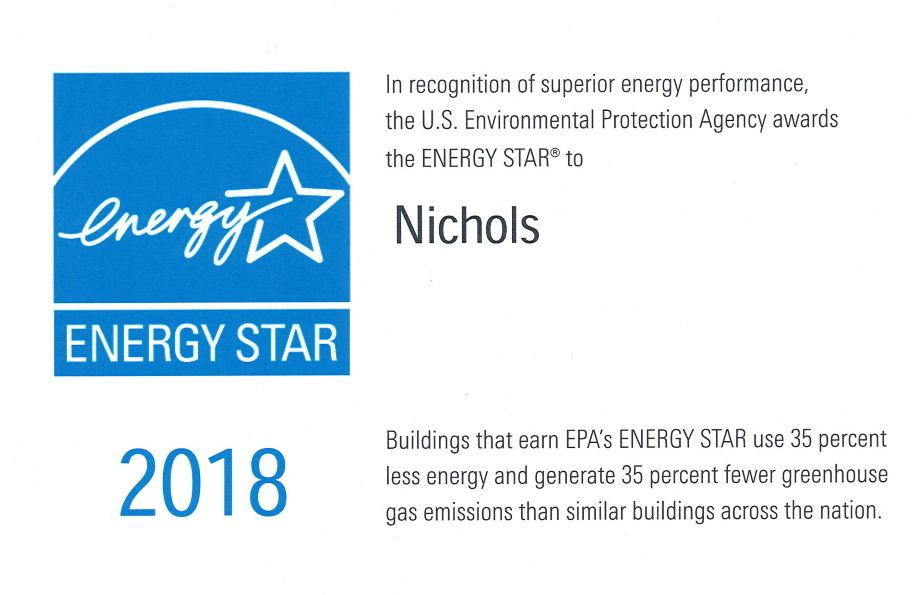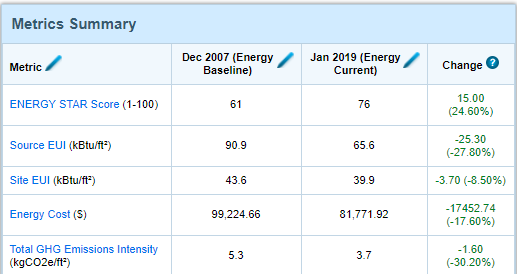No matter where you are at in your organization’s sustainability efforts, it is a journey and there is always an opportunity for continuous improvement. Nichols started our energy efficiency and LEED journey in 2007 at our Norton Shores headquarters and main distribution center. We began with a lighting upgrade from metal halide to 6-lamp florescent fixtures which brought an immediate 34% reduction in energy usage. Electric, by far, is our largest utility expense and we were using upwards of 90,000 kWh per month. In 2010 we achieved LEED for Existing Buildings Operations + Maintenance and with this version of LEED (which is all about operations and maintenance) you must recertify every five years. We achieved Gold level which made us very proud. Here are some of the accomplishments that came along with our original certification:
• Findings regarding our 3 water systems that support the property (one potable and two irrigation systems. One of the irrigation systems was being billed as potable)
• Energy Star Score of 79, Energy Reduction of 34%
• Waste Reduction by recycling
• Reduced net waste hauling fees by 97%
• 2009/2010 Michigan Recycling Coalition Certified Recycler recognition
• Water Use Reduction 41%
Why LEED? LEED really gave us the structure, framework and direction to be more efficient in managing our building. It was, and still is, the best 3rd party green building standard and well-known throughout the world now. Several other reasons we chose to seek LEED certification:
• At that time, one-third of the credits for certification can be obtained from a Green Cleaning Policy and Program
• LEED was a best management practice for our building asset and we understood the importance of that because of our experience with ISO9000
•  Better Indoor air quality for our associates and visitors to our building
Better Indoor air quality for our associates and visitors to our building
• Customer demand – we had several major customers asking that we help them implement green cleaning to meet their needs for a LEED building
• Seeking to be a leader in the community
• The chance to be an industry leader
• Walking the talk
Another important piece of this puzzle are the incentives available from the utility companies, in our case Consumers Energy and DTE. We took advantage of that several times during our energy reduction journey. We made several upgrades from the time of our original LEED certification until our recertification in 2015 under LEED O+M Version 4.0 which gained us a good number of points in the Energy & Atmosphere credit category, 25 of a possible 38. This list describes more accomplishments between 2010 and 2015:
• Reduced energy consumption, 7% in 2014 and winner in the Michigan Battle of the Buildings and 2nd place in 2015 with a 10.84% decrease
• Energy Star score 89
• 2014 Demand Ventilation on HVAC system – this automated fresh air coming into the warehouse and offices, was a manual process. Project cost was $7224.87 and the incentive we received from DTE was $9753.30 (yes, we made money on this one)
• Purchased Renewable Energy Credits to offset energy use
• Composting – started in June 2012 – reducing landfill by approximately 12 yards/annually (4200 pounds)
• 87% waste diversion from landfill
• 2016 – Office Lighting Upgrade from 4 lamp florescent to LED & dock lighting at 22 dock doors to LED, Project Cost approximately $25,000, Incentive approximately $800
So many people told us we would have a difficult time achieving the Gold level of LEED this time around because of the ever evolving upgrades to the standard. We did it! 
You can learn about the incentives from Consumers Energy and DTE by clicking on the links below and more than likely your local utility companies are offering similar programs:
Consumers Energy Rebates and Programs
DTE Energy Rebates
We are excited about our most recent energy upgrade which was completed just this month. We have upgraded the lighting in our distribution center again and this time to LED technology. There are occupancy sensors at the fixture level which allows lighting to be off in areas of the warehouse that are not in use but that turn on quickly when motion is detected. We have reduced the total number of fixtures from 217 to 146 and have significantly increased the candle foot quality of lighting from 6-8 to 18 – that was due to the lighting degradation which happens over time. This project cost was approximately $40,000 and we are expecting an incentive rebate of nearly $7,000.
 So think about this: If Nichols was using the same amount of energy today in the Norton Shores facility that we were using in 2007 at today’s prices of electric and natural gas, we would be spending $30,000 annually more than we are. Cost avoidance of $30,000 annually just by saving energy!
So think about this: If Nichols was using the same amount of energy today in the Norton Shores facility that we were using in 2007 at today’s prices of electric and natural gas, we would be spending $30,000 annually more than we are. Cost avoidance of $30,000 annually just by saving energy!
With the upgrade of the Energy Star rating system our Energy Star Score is now at 76 versus the 89 that it was last year prior to the upgrade. On August 26, 2018, EPA updated performance metrics for U.S. buildings in ENERGY STAR Portfolio Manager® based on the most recent market data available. This much needed update was part of EPA’s standard process to keep ENERGY STAR metrics as current as possible, and reflective of current market performance.
Our LEED commitment and participation in the ISSA Distributor Efficiency Analytics and Learning (DEAL) program help hold us accountable. We are utilizing Energy Star Portfolio Manager and Sustainability Dashboard to track and monitor our progress.
Join us on this journey! We look forward to recertifying out building to LEED O+M Version 4.1 by early 2020.
